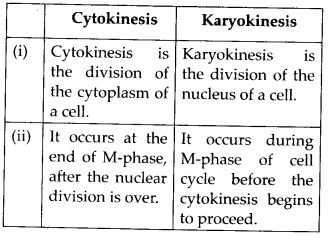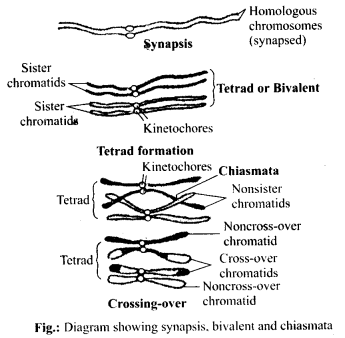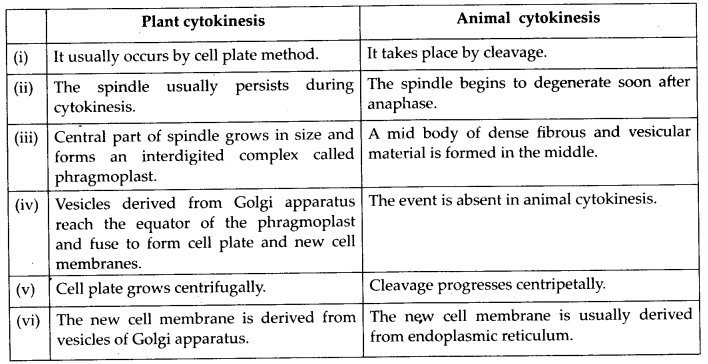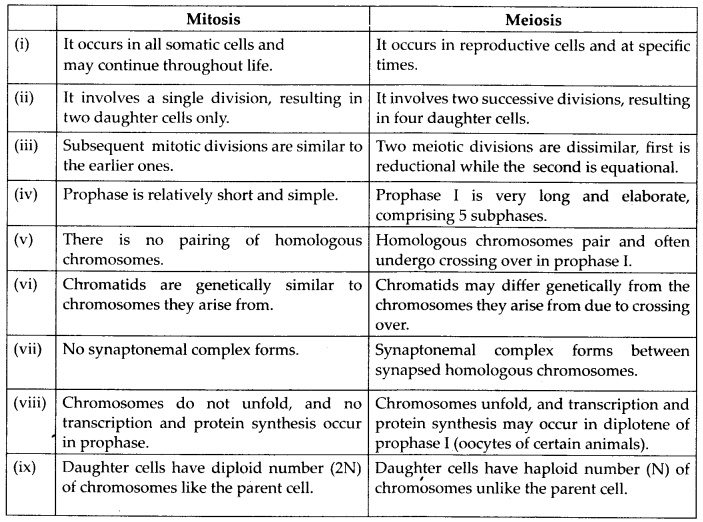Chapter 10 Cell Cycle and Cell Division
Class 11th Biology NCERT Book Solution
NCERT Solutions For Class 11 Biology Cell Cycle and Cell Division
NCRT TEXTBOOK QUESTIONS SOLVED
1. What is the average cell
cycle span for a mammalian cell?
Solution:
24 hours.
2. Distinguish cytokinesis
from karyokinesis.
Solution: Differences
between cytokinesis and karyokinesis are:
3. Describe the events taking
place during the interphase.
Solution: The
interphase, though called the resting phase, is metabolically quite active. It
is the time during which the cell prepares itself for division by undergoing
both cell growth and DNA replication in an orderly manner. The interphase is
further divided into three phases:
• G1 (Gap 1) phase
• S (Synthesis)
phase
• G2 (Gap 2) phase
G1 phase corresponds to the interval between
mitosis of previous cell cycle and initiation of DNA replication. During G1
phase the cell is metabolically active and grows continuously but does not
replicate its DNA S or synthesis phase marks the period during which DNA
synthesis or replication takes place. During this time the amount of DNA doubles
per cell. In animal cells, during the S phase, DNA replication occurs in the
nucleus, and the centriole duplicates in the cytoplasm. During the G2 phase
synthesis of DNA stops while cell growth continues with synthesis of protein and
RNA in preparation for mitosis.
4. What is G0 (quiescent
phase) of cell cycle?
Solution: G0 phase is
the phase of inactivation of cell cycle due to non-availability of mitogens and
energy rich compounds. Cells in this stage remain metabolically active but no
longer proliferate i.e., do not grow or differentiate unless called on to do so
depending on the requirement of the organism. E.g., Nerve and heart cells of
chordates are in permanent G0 phase.
5. Why is mitosis called
equational division?
Solution: Mitosis is a
type of cell division in which chromosomes replicate and become equally
distributed in two daughter nuclei so that the daughter cells come to have the
same number and type of chromosomes as present in parent cell. So mitosis is
called as equational division.
6. Name the stage of cell
cycle at which each one of the following events occur:
(i) Chromosomes are moved to spindle
equator.
(ii) Centromere splits and chromatids separate.
(iii) Pairing between homologous
chromosomes takes place.
(iv) Crossing over between homologous chromosomes takes
place.
Solution:
(i) Metaphase
(ii) Anaphase
(iii) Zygotene of prophase I of meiosis 1
(iv) Pachytene of
prophase I of meiosis I
7. Describe the
following:
(a) Synapsis
(b) Bivalent
(c) Chiasmata
Draw a diagram to illustrate your
answer.
Solution:
(a) Synapsis:
During zygotene of prophase I stage homologou s chromosomes start pairing
together and this process of association is called synapsis. Electron
micrographs of this stage indicate that chromosome synapsis is accompanied by
the formation of complex structure called synaptonemal complex.
(b) Bivalent:
The complex formed by a pair of synapsed homologous chromosomes is called a
bivalent or a tetrad i.e., 4 chromatids or a pair of chromosomes.
(c) Chiasmata: The beginning of diplotene is recognized by
the dissolution of the synaptonemal complex and the tendency of the synapsed
homologous chromosomes of the bivalents to separate from each other except at
the sites of crossovers. These points of attachment (X-shaped structures)
between the homologous chromosomes are called chiasmata.
8. How does cytokinesis in
plant cells differ from that in animal
cells?
Solution: Plant cytokinesis and
animal cytokinesis differ in following respects:
9. Find examples where the
four daughter cells from meiosis are equal in size and where they are found
unequal in size.
Solution: During formation
of male gametes (i.e., spermatozoa) in a typical mammal (i.e., human being), the
four daughter cells formed from meiosis are equal in size. On the other hand,
during formation of female gamete (i.e., ovum) in a typical mammal (i.e., human
being), the four daughter cells are unequal in size.
10. Can there be DNA
replication without cell division?
Solution:
Yes. Endomitosis is the multiplication of chromosomes present in a set
in nucleus without karyokinesis and cytokinesis result-ing in numerous copies
within each cell. It is of 2 types.
Polyteny: Here chromosomes divide and
redivide without separation of chromatids so that such chromosomes become
multistranded with many copies of DNA. Such polytene (many stranded) chromosomes
remain in permanent prophase stage and do not undergo cell cycle e.g., polytene
(salivary glands) chromosome of Drosophila has 512- 1024 chromatids. Here number
of sets of chromosomes does not change.
Polyploidy (endoduplication) : Here
all chromosomes in a set divide and its chromatids separate but nucleus does not
divide. This results in an increase in number of sets of chromosomes in the
nucleus (4x, 8x….). This increase in sets of chromosomes is called polyploidy.
It can be induced by colchicine and granosan. These chromosomes are normal and
undergo cell cycle.
11. List the main differences
between mitosis and
meiosis.
Solution: 
12. Distinguish anaphase of
mitosis from anaphase I of meiosis.
Solution:
Anaphase of mitosis : It is the phase of shortest duration. APC
(anaphase promoting complex) develops. It degenerates proteins -binding the two
chromatids in the region of centromere. As a result, the centromere of each
chromosome divides. This converts the two chromatids into daughter chromosomes
each being attached to the spindle pole of its side by independent chromosomal
fibre. The chromosomes move towards the spindle poles with the centromeres
projecting towards the poles and the limbs trailing behind. There is
corresponding shortening of chromosome fibres. The two pole-ward moving
chromosomes of each type remain attached to each other by interzonal fibres.
Ultimately, two groups of chromosomes come to lie at the spindle poles.
Anaphase I of meiosis : Chiasmata disappear completely and
the homologous chromosomes separate. The process is called disjunction. The
separated chromosomes (univalents) show divergent chromatids and are called
dyads. They move towards the spindle poles and ultimately form two groups of
haploid chromosomes.
13. What is the significance
of meiosis?
Solution: The significance of
meiosis is given below:
(i) Formation of gametes – Meiosis forms gametes that
are essential for sexual reproduction.
(ii) Genetic information – It switches
on the genetic information for the development of gametes or gametophytes and
switches off the sporophytic information. ‘
(iii) Maintenance of chromosome
number – Meiosis maintains the fixed number of chromosomes in sexually
reproducing organisms by halving the same. It is essential since the chromosome
number becomes double after fertilisation.
(iv) Assortment of chromosomes –
In meiosis paternal and maternal chromosomes assort independently. It causes
reshuffling of chromosomes and the traits controlled by them. The variations
help the breeders in improving the races of useful plants and animals.
(v)
Crossing over – It introduces new combination of traits or variations.
(vi)
Mutations – Chromosomal and genomic mutations can take place by irregularities
of meiotic divisions. Some of these mutations are useful to the organism and are
perpetuated by natural selection.
(vii) Evidence of basic relationship of
organisms – Details of meiosis are essentially similar in the majority of
organisms showing their basic similarity and relationship.
14. Discuss with your teacher
about
(i)
haploid insects and lower plants where cell division occurs,
and
(ii)some
haploid cells in higher plants where cell division does not
occur.
Solution:
(i) Cell division
occurs in haploid insect, such as drones of honey bee and lower plant like
gametophyte of algae, bryophytes, and pteridophytes.
(ii) Synergids and
antipodals in embryo sac of ovule are haploid cells where cell division does not
occur.
15. Can there be mitosis
without DNA replication in S-phase?
Solution:
No there cannot be any mitotic division without-DNA replication in ‘S’
phase.
16. Analyse the events during
every stage of ceil cycle and notice how the following two parameters
change.
(i)
number of chromosomes (N) per cell
(ii) amount of DNA content (C) per cell
Solution:
Number of chromosomes and amount of DNA change during S-phase and
anaphase of cell cycle. S or synthesis phase marks the period during which DNA
synthesis or replication takes place. During this time the amount of DNA per
cell doubles. If the initial amount of DNA is denoted as 2C then it increases to
4C. However, there is no increase in the chromosome number; if the cell had
diploid or 2N number of chromosomes at G„ even after S phase the number of
chromosomes remains the same, i.e., 2N.
In mitotic anaphase, number of
chromosomes remains the same. It is only sister chromatids which move towards
their respective poles. DNA content remains unchanged. In anaphase I of meiosis,
number of chromosomes are reduced to half, i.e., from 2N to IN and also DNA
content decrease to one half i.e., from 4C to 2C. In anaphase II of meiosis II
DNA content decreases to one half from 2C to 1C but chromosome number remain
same.